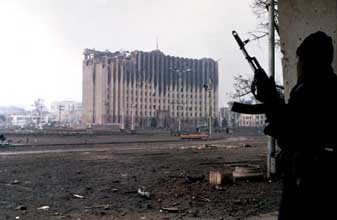This is a scalable context timeline. It contains events related to the event 1991-1997: Oil Investment in Central Asia Follows Soviet Collapse. You can narrow or broaden the context of this timeline by adjusting the zoom level. The lower the scale, the more relevant the items on average will be, while the higher the scale, the less relevant the items, on average, will be.

1991-1997: Oil Investment in Central Asia Follows Soviet Collapse
The Soviet Union collapses in 1991, creating several new nations in Central Asia. Major US oil companies, including ExxonMobil, Texaco, Unocal, BP Amoco, Shell, and Enron, directly invest billions in these Central Asian nations, bribing heads of state to secure equity rights in the huge oil reserves in these regions. The oil companies commit to $35 billion in future direct investments in Kazakhstan. It is believed at the time that these oil fields will have an estimated $6 trillion potential value. US companies own approximately 75 percent of the rights. These companies, however, face the problem of having to pay exorbitant prices to Russia for use of the Russian pipelines to get the oil out. [NEW YORKER, 7/9/2001; ASIA TIMES, 1/26/2002]
December 11, 1994: Russia Invades Breakaway Region of Chechnya, Starting First Chechen War

A Chechen rebel looks at the government palace in Grozny, Chechnya, in January 1995. [Source: Mikhail Evstafiev]
In 1991, with the collapse of the Soviet Union, Dzhokhar Dudayev won an election in Chechnya, which is a region within Russia and not a republic like Ukraine or Kazakhstan. Nonetheless, Dudayev proclaimed Chechnya independent of Russia. The next year, Chechyna adopted a constitution defining it as an independent, secular state. But Russia did not recognize Chechnya’s independence. In November 1994, Russia attempted to stage a coup in Chechnya, but this effort failed. The next month, on December 11, Russian troops invade Chechnya. This starts the first Chechen war. Up to 100,000 people are killed in the 20-month war that follows. The war will end in August 1996 (see August 1996). [BBC, 3/16/2000; BBC, 3/12/2008]
August 1997: CIA Monitors Central Asia for Oil Reserves
The CIA creates a secret task force to monitor Central Asia’s politics and gauge its wealth. Covert CIA officers, some well-trained petroleum engineers, travel through southern Russia, Azerbaijan, Kazakhstan, and Turkmenistan to sniff out potential oil reserves. [TIME, 5/4/1998]
Fall 2002-January 2003: US State Departments and Former Oil Executives Plan Iraq’s Post-Invasion Oil Industry
The Bush administration picks Philip Carroll, a former CEO of Royal Dutch/Shell’s US division, to advise post-Saddam Iraq’s oil ministry. [HARPER'S, 4/2005, PP. 74-76] He is formally appointed in January 2003 along with Gary Vogler of ExxonMobil, three employees of the US Department of Energy, and an employee of the Australian government. In the months before the invasion, they are sent to Kuwait where they “begin planning for the restructuring of the ministry of oil to improve its efficiency and effectiveness [and] begin thinking through Iraq’s strategy options for significantly increasing its production capacity,” Carroll later explains. [MUTTITT, 2005]
May 28, 2006: Baku-Tbilisi-Ceyhan Oil Pipeline Opens
The first oil pumped from Baku, by the Caspian Sea in Azerbaijan, arrives in Ceyhan, on Turkey’s Mediterranean coast, and is loaded onto a ship. The 1,770 km pipeline, which passes through the Georgian capital of Tbilisi, bypasses Russia and Iran for geopolitical reasons. The main shareholder is British Petroleum, and other significant shareholders include the State Oil Company of Azerbaijan (SOCAR), Statoil of Norway, and the US company Unocal, which has an 8.9% interest and became interested in the project no later than 1998. Unocal begins losing interest in a pipeline across Afghanistan around the same time (see December 5, 1998). Substantial amounts to finance the $3-4 billion Baku-Tbilisi-Ceyhan (BTC) pipeline were arranged by the World Bank’s International Finance Corporation and the European Bank for Reconstruction and Development. The consortium members put up the remaining 30%. [US CONGRESS, 2/12/1998; ALEXANDER'S GAS AND OIL CONNECTIONS, 7/12/2002; GUARDIAN, 12/1/2003; GUARDIAN, 5/26/2005; EURASIA DAILY MONITOR, 5/31/2005; TURKISH WEEKLY, 5/29/2006] Journalist Pepe Escobar comments: “In terms of no-holds-barred power politics and oil geopolitics, BTC is the real deal—a key component in the US’s overall strategy of wrestling the Caucasus and Central Asia away from Russia—and bypassing Iranian oil and gas routes… BTC makes little sense in economic terms. Oil experts know that the most cost-effective routes from the Caspian would be south through Iran or north through Russia. But BTC is a designer masterpiece of power politics—from the point of view of Washington and its corporate allies. US Vice President Dick Cheney, already in his previous incarnation as Halliburton chief, has always been a huge cheerleader for the ‘strategically significant’ BTC.” Escobar also mentions that the amount of Caspian oil was overestimated (see November 1, 2002), “the Caspian may hold only 32 billion barrels of oil—not much more than the reserves of Qatar, a small Gulf producer.” [ASIA TIMES, 5/26/2005] However, the Caspian area is still believed to hold considerable amounts of natural gas. The construction of this pipeline does not halt plans for the construction of a natural gas pipeline from Turkmenistan across Afghanistan to the Indian Ocean (see January 18, 2005).
Source: historycommons.org